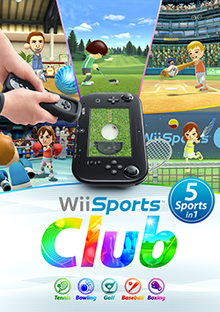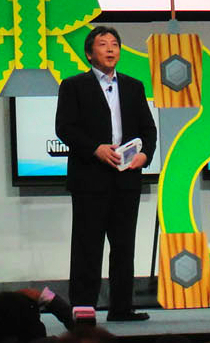A sports video game is a video game that simulates the practice of sports. Most sports have been recreated with video games, including team sports, track and field, extreme sports, and combat sports. Some games emphasize playing the sport, whilst others emphasize strategy and sport management. Some, such as Need for Speed, Arch Rivals and Punch-Out!!, satirize the sport for comic effect. This genre has been popular throughout the history of video games and is competitive, just like real-world sports. A number of game series feature the names and characteristics of real teams and players, and are updated annually to reflect real-world changes. The sports genre is one of the oldest genres in gaming history.
Super Smash Bros. is a crossover platform fighting game series published by Nintendo. The series was created by Masahiro Sakurai, who has directed every game in the series. The series is known for its unique gameplay objective which differs from that of traditional fighters, in that the aim is to increase damage counters and knock opponents off the stage instead of depleting life bars.

Golf is a golf-based sports simulation video game developed and released by Nintendo in 1984 for the Famicom in Japan. Later the same year, it was ported to the Nintendo VS. System as VS. Golf or Stroke and Match Golf, released in arcades internationally, followed by another arcade version called VS. Ladies Golf. The original was re-released for the NES in North America in 1985, and for the Famicom Disk System in 1986 in Japan.

Wii Sports is a 2006 sports simulation video game developed and published by Nintendo for the Wii video game console. The game was released in North America along with the Wii on November 19, 2006, and in Japan, Australia, and Europe the following month. It was included as a pack-in game with the console in all territories except Japan, making it the first sports game included with the launch of a Nintendo system since Mario's Tennis for the Virtual Boy in 1995. The game was later released on its own as part of the Nintendo Selects collection of games.

A Mii is a customizable avatar used on several Nintendo video game consoles and mobile apps. The name Mii is a portmanteau of "Wii" and "me", referring to them typically being avatars of the players. Miis were first introduced on the Wii console in 2006 and later appeared on the DS, 3DS, the Wii U, the Switch, and various apps for smart devices such as Miitomo. Miis can be created using different body, facial and clothing features, and can then be used as characters within games on the consoles, either as an avatar of a specific player or in some games portrayed as characters with their own personalities. Miis can be shared and transferred between consoles, either manually or automatically with other users over the internet and local wireless communications.

The Japanese multinational consumer electronics company Nintendo has developed seven home video game consoles and multiple portable consoles for use with external media, as well as dedicated consoles and other hardware for their consoles. As of September 30, 2021, in addition to Nintendo Switch, Nintendo has sold over 863.07 million hardware units.
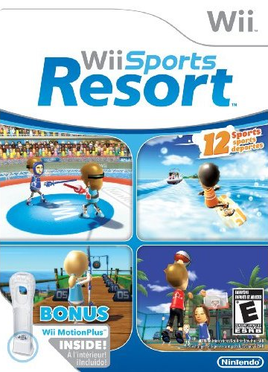
Wii Sports Resort is a 2009 sports simulation video game developed and published by Nintendo for the Wii video game console and is the sequel to Wii Sports. It is the first first-party Wii game to support the Wii MotionPlus accessory and the first one overall to require it, which was bundled with the game. Wii Sports Resort was first announced at E3 2008 and was released in Japan on June 25, 2009, and in nearly all other regions the following month. While Wii Sports Resort was first released as a stand-alone title, it was later bundled with newer Wii consoles alongside Wii Sports.

Wii is a series of simulation games published by Nintendo for the game console of the same name, as well as its successor, the Wii U. After a seven-year hiatus, the game Nintendo Switch Sports, described officially as "a new iteration of the Wii Sports series," was announced, the first game to drop the "Wii" from its title. These games feature a common design theme, with recurring elements including casual-oriented gameplay, casts consisting mostly or entirely of Miis, and control schemes that simulate real-life activities.
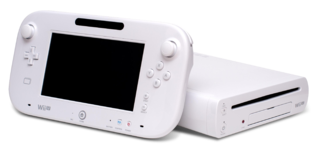
The Wii U is a home video game console developed by Nintendo as the successor to the Wii. Released in late 2012, it is the first eighth-generation video game console and competed with Microsoft's Xbox One and Sony's PlayStation 4.
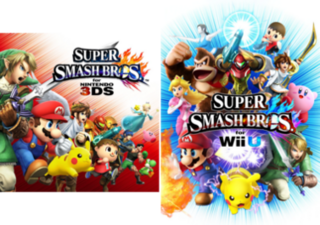
Super Smash Bros. for Nintendo 3DS and Super Smash Bros. for Wii U, both commonly referred together as Super Smash Bros. 4, are 2014 crossover platform fighter video games developed by Bandai Namco Studios and Sora Ltd. and published by Nintendo for the Nintendo 3DS and Wii U video game consoles. It is the fourth installment in the Super Smash Bros. series, succeeding Super Smash Bros. Brawl. The Nintendo 3DS version was released in Japan on September 13, 2014, and in North America, Europe, and Australia the following month. The Wii U version was released in North America, Europe, and Australia in November 2014 and in Japan the following month.

The Wii U GamePad is the standard game controller for Nintendo's Wii U home video game console. Incorporating features from tablet computers, the GamePad has traditional input methods, touchscreen controls, and motion controls. The touchscreen can be used to supplement a game by providing alternate, second screen functionality or an asymmetric view of a scenario in a game. The screen can also be used to play a game strictly on the GamePad screen without the use of a television display. Conversely, non-gaming functions can be assigned to it as well, such as using it as a television remote.
The Nintendo Network is a defunct online service formerly ran by Nintendo that provided free online functionality for the Nintendo 3DS and Wii U systems and their compatible games. Announced on January 26, 2012, at an investors' conference, it was Nintendo's second online service after Nintendo Wi-Fi Connection. Former president of Nintendo Satoru Iwata said, "Unlike Nintendo Wi-Fi Connection, which has been focused upon specific functionalities and concepts, we are aiming to establish a platform where various services available through the network for our consumers shall be connected via Nintendo Network service so that the company can make comprehensive proposals to consumers."

Miiverse is a discontinued social network for Nintendo 3DS and Wii U that was created by Nintendo System Development and Hatena, and powered by the Nintendo Network. Integrated into many games, Miiverse allowed players to interact and share their experiences by way of handwritten messages or drawings, text, screenshots, and sometimes game videos in dedicated communities. It was available via any web browser, and a dedicated app version was originally planned for tablets and smartphones. All users who signed up for a Nintendo Network ID were automatically given a Miiverse profile per account, represented by the Mii avatar connected to said Nintendo Network ID.

Game & Wario is a 2013 party video game developed by Nintendo and Intelligent Systems and published for the Wii U console, named after LCD Game & Watch titles. It is the eighth installment in the WarioWare series and part of the larger Mario franchise. The story stars Wario and his friends, who take advantage of a newly released video game console with two separate screens by making games for monetary gain. Game & Wario consists of 16 minigames that exclusively utilize the Wii U GamePad and its functions. Additional modes and collectibles are also unlockable. The majority of the minigames are single-player, although some are designed for multiplayer only.
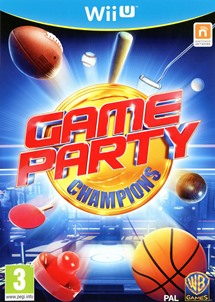
Game Party Champions is the fifth video game in the Game Party series, releasing as a launch title for the Wii U console in North America and Europe. It is the successor to Game Party: In Motion.

The Wii U operating system is the official firmware version and system software for the Nintendo's Wii U home video game console. Nintendo maintains the Wii U's systemwide features and applications by offering system software updates via the Internet. Updates are optional to each console owner, but may be required in order to retain interoperability with Nintendo's online services. Each update is cumulative, including all changes from previous updates.
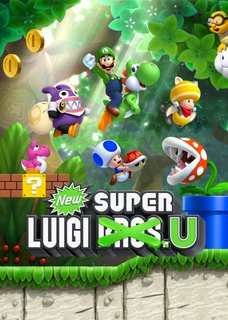
New Super Luigi U is a 2013 platform game developed by Nintendo for the Wii U. It is an expansion pack for New Super Mario Bros. U (2012), part of the Super Mario series. The plot and game mechanics remain identical to New Super Mario Bros. U, but Luigi replaces Mario as the protagonist. Luigi jumps higher and has less ground friction than Mario, and every level is redesigned to increase the difficulty level. The expansion adds Nabbit, a non-player character from New Super Mario Bros. U, as an invincible playable character.

The Year of Luigi was the 30th-anniversary celebration of the fictional character Luigi. He was created by Japanese video game designer Shigeru Miyamoto for the 1983 arcade game Mario Bros. and has appeared frequently as a minor or supporting character in the Mario franchise since. Due to Nintendo's decision to develop Luigi's Mansion: Dark Moon and Mario & Luigi: Dream Team at the same time, they declared 2013 the Year of Luigi. According to Mario creator Shigeru Miyamoto, Nintendo staff members also had the urge to develop games focused on Luigi, and considered the character underrepresented compared to Mario. It was announced via Nintendo Direct on February 14, 2013, by Nintendo CEO Satoru Iwata and ended on March 18, 2014.

Star Fox Zero is a 2016 rail shooter video game developed by Nintendo and PlatinumGames for the Wii U. It is the sixth installment in the Star Fox series. Formally announced at E3 2015, the game was released in April 2016 to mixed critical reception, with the most polarizing aspect of the game being its control scheme. A standalone tower defense game, titled Star Fox Guard, was bundled with the game.

Sports Connection, known in North America as ESPN Sports Connection, is a sports video game published by Ubisoft. It was released as a launch title for the Wii U in North America and Europe.
